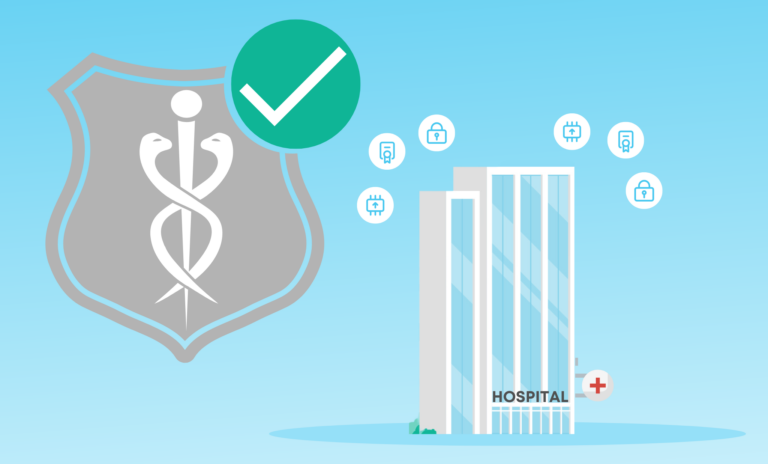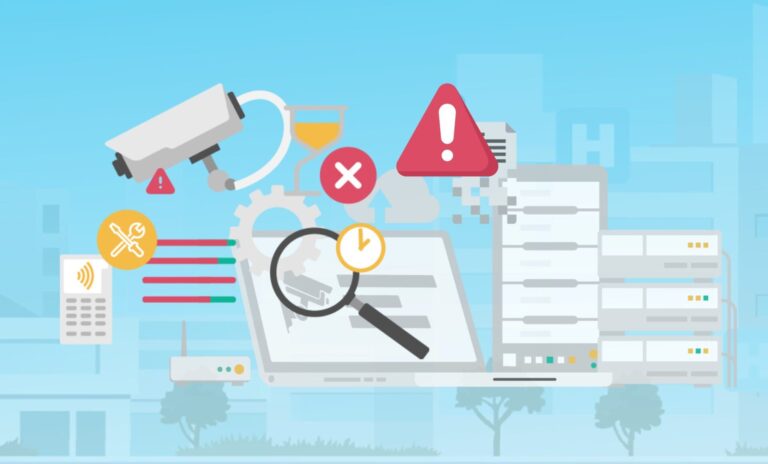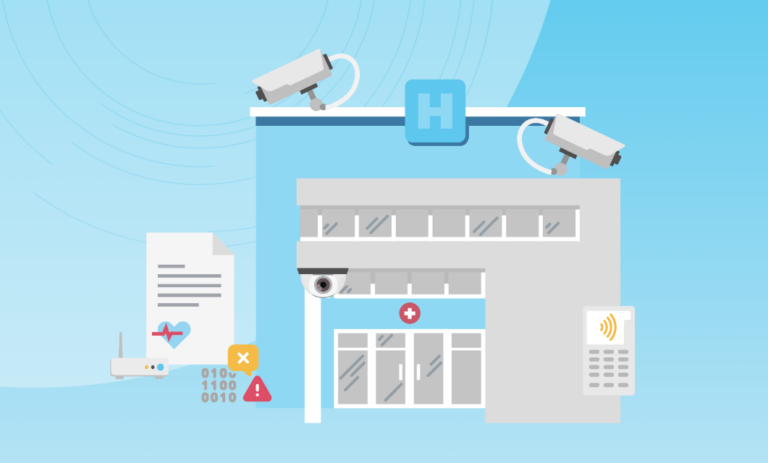 How to Prevent Workplace Violence in Healthcare Facilities
How to Prevent Workplace Violence in Healthcare Facilities
Healthcare workers experience workplace violence at nearly four times the rate of other industries. These incidents range from verbal threats to physical attacks, endangering staff safety and compromising patient care. While traditional security guards provide some protection, they aren’t enough on their own. The most effective approach combines advanced security technology with comprehensive staff training programs.
This article outlines six evidence-based strategies that healthcare facilities can implement to reduce violence risks and create safer environments. Implementing these strategies allows facilities to better protect their most valuable resources: their healthcare professionals.
Understanding Workplace Violence in Healthcare
Healthcare professionals face multiple safety challenges, with violence occurring far too frequently in settings meant for healing. Understanding the nature, scope, and triggers of these incidents is the first step in learning how to prevent workplace violence in healthcare through effective prevention strategies.
Defining Workplace Violence in Healthcare Environments
Workplace violence in healthcare means any kind of threat, harassment, or actual physical harm that happens in a medical setting. This can include yelling, insults, pushing, hitting, or even deadly attacks, whether these come from patients, visitors, coworkers, or outsiders who shouldn’t be there at all. And it can happen almost anywhere: in ERs, patient rooms, waiting areas, or even parking lots. Since these situations can happen suddenly and without warning, they’re very hard to handle without a clear, organized plan in place.
Current Statistics and Prevalence of Healthcare Violence
The numbers reveal concerning trends about healthcare workplace safety. According to the CDC’s National Institute for Occupational Safety and Health, 20,050 workers in private industry experienced trauma from nonfatal workplace violence that required days away from work. Of those, a whopping 76% worked in the healthcare and social assistance industry.
Common Risk Factors in Healthcare Facilities
Identifying what triggers violent incidents helps focus prevention efforts. Key risk factors include:
- Patient-related factors: Patients experiencing mental health crises, substance abuse issues, dementia, or extreme pain may lash out when feeling confused, frightened, or unable to communicate needs effectively.
- Environmental conditions: Overcrowded waiting rooms, long wait times, poor lighting in corridors or parking areas, and limited security presence can create conditions where frustration escalates to aggression.
- Organizational issues: Understaffing leads to overworked personnel who may have less patience or time for de-escalation, while insufficient security protocols leave staff vulnerable during critical moments.
Recognizing these patterns is essential for facilities aiming to understand how to prevent workplace violence in healthcare. This allows healthcare facilities to implement targeted strategies that address all violence risk factors—rather than just focusing on physical security measures—when considering how to prevent workplace violence in healthcare.
Key Technology Qualities for Maximum Efficiency
As healthcare facilities continue to invest in advanced security technologies to reduce workplace violence in healthcare, they must understand that the value of these systems depends not only on their features but also on how reliably and securely they operate. For a violence prevention strategy to succeed, healthcare organizations must ensure that their technology meets three essential criteria: operational readiness, regulatory compliance, and protection against cybersecurity threats.
1. Operational Readiness
Healthcare environments are high-stakes and fast-moving. When violence occurs, staff rely on systems like panic buttons, surveillance cameras, and door-locking mechanisms to work instantly and flawlessly.
Unfortunately, many hospitals operate hundreds (or even thousands) of security devices across multiple sites. Without centralized oversight or automated health monitoring, it’s easy for devices to go offline without this being noticed. Needless to say, a camera that’s been down for weeks or a panic button that isn’t transmitting correctly can create dangerous blind spots in your facility’s response capabilities.
To maintain operational readiness, healthcare organizations should do the following:
- Regularly monitor device status and performance using centralized platforms
- Proactively detect and resolve device malfunctions before they impact safety.
- Conduct periodic system testing and staff response drills to ensure everything functions as intended.
When every second counts, technology should perform without hesitation.
2. Regulatory Compliance
Healthcare security doesn’t exist in a vacuum; it operates within strict regulatory frameworks, including OSHA’s General Duty Clause and HIPAA regulations. Facilities are not only expected to create safe environments but also to protect sensitive patient information, especially as security systems increasingly integrate with digital platforms.
Failing to meet compliance standards can result in legal liabilities, financial penalties, and reputational harm—particularly after a violent or high-risk incident.
Security systems should support compliance by:
- Logging access attempts and incident responses in a secure, reviewable format
- Integrating with electronic health records and incident reporting tools to ensure traceability
- Providing audit-friendly reports that demonstrate adherence to both safety protocols and data privacy requirements
With the growing role of network-connected devices in physical security, HIPAA compliance must be a central part of cybersecurity strategies to ensure that protected health information isn’t exposed or compromised during system breaches.
3. Cybersecurity Protection
Today’s physical security tools—like cameras, badge readers, and smart locks—are often connected to hospital networks via a technology generally called the Internet of Things (IoT). While this integration enhances functionality and control, it also introduces cybersecurity risks that can directly impact physical safety. For example, a hacked camera system or compromised access control platform can disable critical security features, expose sensitive data, or even allow unauthorized individuals into restricted areas.
To protect against cyber vulnerabilities, healthcare organizations should take specific actions:
- Ensure that all devices are updated regularly with security patches and firmware updates.
- Use strong encryption protocols for communication between devices and systems.
- Monitor network behavior in real time for signs of unauthorized access or anomalies.
Technology-Driven Prevention Solutions
Security technology serves as a critical layer in healthcare violence prevention. Advanced systems not only provide immediate response capabilities but also gather valuable data to help identify patterns and prevent future incidents.
Here are three more important areas to look at:
4. Advanced Security Monitoring Systems and Intelligent Video Analytics
Modern healthcare facilities are moving beyond traditional CCTV by deploying intelligent security monitoring systems that incorporate advanced analytics and video intelligence. These solutions provide comprehensive surveillance coverage, improve threat detection, and streamline emergency response.
Integrated monitoring platforms enable security teams to monitor multiple zones simultaneously through centralized dashboards, analyze behavior and motion to detect unusual activity or potential threats, and link with access control systems to verify identities and track movements across the facility.
A key advancement in these systems is the use of intelligent video analytics powered by computer vision. These tools identify behavior patterns and preemptively flag violence triggers such as:
- Loitering in sensitive areas
- Unauthorized access attempts
- Weapons being carried
- Multiple individuals entering restricted zones
Some platforms include facial recognition capabilities to spot known high-risk individuals and can integrate with electronic health records to alert staff about patients with a history of aggressive behavior.
By combining real-time alerts, automated incident logging, and predictive analysis, these systems significantly boost situational awareness—particularly in high-risk areas like emergency rooms or psychiatric units—offering critical protection for both patients and staff.
5. Real-Time Incident Reporting Platforms
Quick and accurate incident reporting directly impacts both response effectiveness and prevention efforts. Mobile reporting tools allow staff to document violent or potentially violent situations without leaving their work area or patients. These platforms typically include:
- Mobile panic buttons that staff can activate discreetly from smartphones or wearable devices, sending their exact location to security personnel
- Streamlined documentation tools with standardized forms that capture crucial details while requiring minimal time to complete
- Automated alerts that notify appropriate response teams based on incident severity and location
- Incident tracking databases that help identify patterns, high-risk areas, and effectiveness of interventions
6. Integration of AI for Predictive Analysis
Artificial intelligence tools analyze historical incident data alongside current environmental factors to forecast potential violence risks. AI continuously learns from new data, becoming increasingly accurate at identifying situations where intervention might prevent escalation.
AI enhances violence prevention in healthcare in multiple ways, as shown in the table below.
| AI Application | Function | Benefits |
| Natural Language Processing | Analyzes verbal communications for escalating tension | Early detection of verbal aggression before physical escalation |
| Pattern Recognition | Identifies connections between environmental factors and incidents | Helps adjust staffing and security based on predicted risk levels |
| Behavioral Anomaly Detection | Flags unusual patient or visitor behaviors | Allows preemptive intervention before crisis situations develop |
Communication Technologies for Rapid Response
When violence does occur, every second matters. Integrated communication systems ensure that the right responders arrive quickly with the information they need.
Leading healthcare facilities implement multi-channel communication systems that include essential features such as these:
- Silent alarm networks that allow staff to trigger assistance without alerting aggressors
- Mass notification systems that can instantly alert entire departments or buildings about threats
- GPS-enabled responder tracking that directs the nearest security personnel to incident locations
- Two-way communication devices that enable responders to receive real-time updates about evolving situations
These technologies work most effectively when integrated into a unified security management platform that coordinates all safety systems. This approach ensures that when a staff member activates an emergency button, the system automatically locks appropriate doors, alerts security personnel, and provides responders with live video feeds of the situation.
However, as healthcare facilities increasingly rely on connected devices, it’s critical to address IoT vulnerabilities that could compromise these systems. Learn more about how IoT security risks affect hospital environments here.
Developing a Violence Prevention Program
Knowing how to prevent workplace violence in healthcare starts with a structured program that empowers staff while creating systems that identify and address risks before they escalate. This section outlines the key components needed to build a robust violence prevention framework.
Staff Training and De-escalation Techniques
Healthcare workers need specific skills to recognize warning signs and safely manage potentially violent situations. Training programs should be tailored to each facility’s unique needs and regularly updated based on incident data.
Facility Risk Assessments
Regular security assessments help identify physical and operational vulnerabilities before they contribute to violent incidents. These evaluations should examine everything from building access points to staffing patterns during high-risk periods.
Here are some specific ideas:
- Map high-risk zones: Identify areas with previous incidents or environmental risk factors like isolated locations or limited visibility.
- Evaluate physical safeguards: Assess the effectiveness of barriers, locks, lighting, and surveillance coverage throughout the facility.
- Review staffing patterns: Analyze whether adequate personnel are available during high-risk periods, especially nights and weekends.
- Test response protocols: Conduct drills to ensure that security teams can reach any location within established response time standards.
- Gather staff feedback: Survey frontline workers about perceived security gaps and near-miss incidents that weren’t formally reported.
Clear Reporting Protocols
Many violent incidents go unreported because staff lack clear guidance on what to report and how. Effective reporting systems make the process straightforward while ensuring appropriate follow-up actions.
Without consistent reporting of all incidents, even minor ones, patterns remain hidden and prevention efforts are built on incomplete data.
Reporting protocols should explicitly classify what constitutes reportable behavior, from verbal threats to physical contact. Forms should be accessible electronically and require minimal time to complete.
A Culture of Safety and Support
Perhaps the most critical element is creating an organizational culture where safety is everyone’s responsibility and violence is never accepted as being “part of the job.” This cultural shift starts with visible leadership commitment. Leadership should consistently communicate the fact that staff safety receives the same priority as patient care. This includes implementing post-incident support services like critical incident debriefing and counseling for affected staff.
Implementing Security Management Solutions: Centralizing Security Device Management
Security management platforms address all of the vulnerabilities discussed above by unifying control and oversight of all security elements.
Centralized platforms connect previously siloed security systems—including access control, video surveillance, panic buttons, and emergency communication tools—into a single management interface that provides complete visibility across all devices and locations. This approach eliminates dangerous gaps between systems while reducing the administrative burden on security teams. Staff can monitor all security elements through one dashboard, ensuring faster response times during potential violence situations.
Implementing security management solutions like SecuriThings gives healthcare facilities multi-angle oversight of their security infrastructure while ensuring that all preventive measures function properly when needed most.
Creating Safer Healthcare Environments Through Technology and Training
Healthcare facilities can substantially reduce violent incidents through the implementation of thorough monitoring systems, staff education programs, straightforward reporting methods, and unified physical security platforms. This creates environments where personnel feel both protected and valued.
The most effective violence prevention strategies anticipate threats, empower staff, and create systems where protection becomes part of the healthcare culture itself. Contact us today to discover how our integrated physical security management solutions can help your organization build a more robust violence prevention program while keeping your existing security investments delivering maximum protection for your healthcare team.
FAQs
What are the most effective ways to prevent workplace violence in healthcare when dealing with patients in crisis?
Setting up early warning systems helps staff notice behavior changes before they escalate. Making sure you have enough personnel during tense periods reduces risks substantially. Training your team in specific techniques to calm agitated patients makes a major difference. Many hospitals find that creating dedicated teams with special training for mental health emergencies or substance withdrawal situations dramatically cuts down violent incidents.
How can we prevent workplace violence with a limited security budget?
When security budgets are tight, healthcare facilities can still effectively prevent workplace violence using cost-effective approaches. Simple changes like better lighting and rearranging furniture for clear sightlines cost little but help a lot. Using standardized tools to assess violence risk adds structure without major expense. Staff training can use materials from OSHA and NIOSH.
For technology solutions, start with high-risk areas like emergency rooms and mental health units first, then gradually expand to other departments as funding allows.
What role do patients’ families play in preventing or contributing to workplace violence in healthcare?
Families can either help prevent or sometimes contribute to workplace violence in healthcare settings. When staff clearly communicate about rules, what to expect from treatments, and visiting hours, this reduces misunderstandings that lead to frustration and potential aggression. Programs that actively involve families, teaching them how to spot early warning signs of agitation and proper ways to speak up for their loved ones, often turn potentially difficult family members into helpful partners in keeping everyone safe.


 How to Prevent Workplace Violence in Healthcare Facilities
How to Prevent Workplace Violence in Healthcare Facilities

